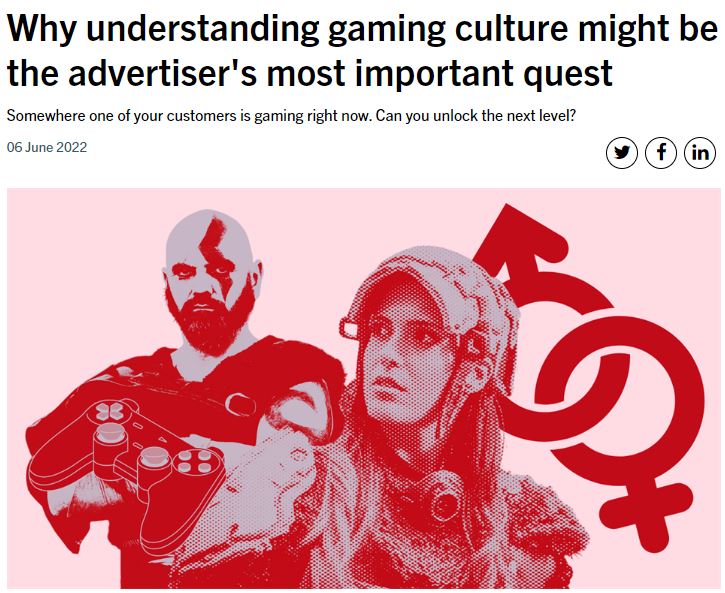Gaming is everywhere these days and it might not look how you think it does, says Paul Cranwell, Vice President Strategic Partnerships at AdTonos…
The first thing you need to know about gamers is that we probably shouldn’t really be calling them ‘gamers’. Outdated stereotypes of young men tucked away in dark basements don’t hold true – if they ever really did.
What is true, however, is that gaming has become as ubiquitous as mobile phones and other electronic devices themselves, with anyone getting their fill of online entertainment whenever they like – which means it’s long past time advertisers reformatted these prejudices about teenage boys and embraced the opportunity to engage with the whole population.
Intrusive or interruptive advertising formats are the killers of an enjoyable experience, and it’s clear that knowing the subtleties of a good gaming advert should be the number one priority for marketers if they are to avoid controversies such as UFC 4 or Street Fighter 5.
Know your players
Advertisers often need to think of categories in order to place their ads effectively. However, as we know, truly connecting and communicating with an audience requires understanding that audience…
For one, you will always have your ‘hardcore’ gamers – those that play as soon as the opportunity arises, which can also include those that play professionally – but you also have ‘core’ and ‘casual’ gamers, depending on the time, price and difficulty of games played. But don’t get fooled, there are children who play, parents who play alongside their children, men, women… anyone could be in this category.
The kind of device used can also, to a certain extent, define the type of gamer: mobile gamers are on the more casual side, whereas console players and PC players are willing to invest more time and money in the activity. When it comes to games categories themselves, there’s simulation (such as The Sims), Role-Playing Games (RPG – think The Witcher or Elden Ring), e-sports (FIFA, Call of Duty, Fortnite), Match-3 (puzzles like Candy Crush), strategy (Clash of Clans), adventure (Uncharted, Star Wars), hyper-casual (Helix Jump) and casual casino (Prominence Poker).
Some players are very open to watching or listening to an ad in exchange for in-app rewards such as a particular currency or unlocking some other prize. Casual gamers who are used to playing free games with ads – think perhaps commuters playing puzzles – are more likely to be receptive over very heavily-invested and focused console players who might resent any intrusion. However, in total nearly three-quarters (74%) of gamers are open to ad-supported models – which is probably part of the reason why 93% of media buyers are looking to run in-game advertising by 2025.
With this abundance in categories and sub-categories – you could probably break these down continuously – it is clear that those wishing to tap into this audience might want to start thinking about this strategically.
Understand the rules of the game
History has proven that gamers will happily – and vocally – let brands and platforms know if they don’t approve of something, which is why the advertising industry needs to be careful when it comes to getting involved in the game. Fortunately audio advertising circumvents this issue by engaging highly immersed players without actually interrupting gameplay – and when you can integrate the ad in a way that benefits the player, you’ve got yourself a triple threat.
Advertisers must be careful however not to fall into the trap of applying their existing radio audio ads to gamers. Just as you should not run a radio ad on a podcast, ads in gaming sit somewhere between the two and need to be slightly different in their style in order to maximise engagement.
There are a lot of different ways brands can slot audio ads into a gaming environment, but when you do you need to make sure that you work within the parameters of the game: how are you using music, how are you adding to the atmosphere, to the sense of winning and excitement? Even when you opt for pre-, mid- or post-roll audio ads during loading times, the transition from play to ad needs to be seamless.
This is why mid-play ads are best reserved for puzzles, while ads that are triggered on setup, intermission or a high score would work better during sport or action games. And when a player can win currency or another prize mid-game by watching an ad, they have the choice to opt-in – ensuring a willingness on behalf of the player.
However it’s played out, the ad needs to be useful, either by being entertaining or adding value in other ways. This means you need to go further than just picking the right kind of ad for the right kind of game – it also means working with partners that know the field, partners that can help you leverage first-party data insights, as well as finding the right kind of technology and tools to help measure your success, such as you would for any other media activity.
Deliver your knock-out combo
The world of gaming and gamers is nowhere near as niche as it once was, especially when it comes to mobile – players spend over 8 hours a week on video games, and clock in around 20 minutes a day on mobile. With near gender parity and an average age of 36, gaming is a great way to get in touch with a whole new audience – one that is engaged and willing to watch ads in exchange for a reward. This will take a lot of planning, strategising, and perfect execution, but much like any game, it will come with extremely satisfying rewards.
This article was also featured in Performance Marketing World here.



